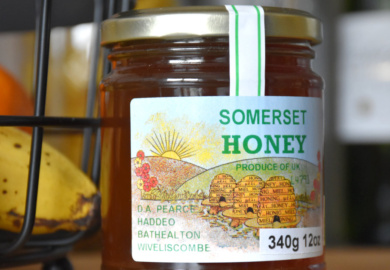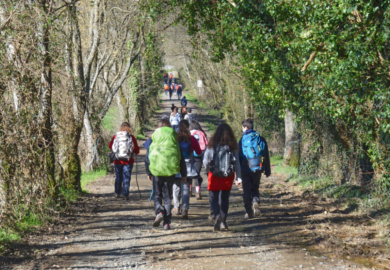Plotting out a circular walk from Lynmouth to Watersmeet sounded like a simple enough task. We had an OS Map, a Rocks, Rivers and Romance local map we’d picked up from the National Trust campsite we were staying at, and there were signposts and info boards along the way with maps. So why did we find plotting out a route a tad on the confusing side?
Because the reality and the info on the ground don’t always match up.
The starting point
We chose to park at the Esplanade Cark in Lynmouth. It meant we got to enjoy a short wander through pretty Lynmouth before reaching the start of the walk, taking note of potential places for an ice cream/fish and chips/pasty at the end of the route. Some websites recommend the Lower Lyndale car park, where crowds congregate to catch the Exmoor Coaster bus. There’s also a small parking area right at the official start of the route, on the left side of the East Lyn River.
We started our route along the opposite bank. Why? Because there was a path, and a rather nice one at that. The route along the right-hand side of the river passes right below the Middleham Gardens, a memorial to the hamlet of Middleham whose cottages were swept away during the terrible floods of 1952 that took the lives of 34 people. After a couple of hundred metres, we crossed the river to join the official route, prompted by a sign pointing to Watersmeet. The OS Map shows a dotted path continues on the right side, but dotted paths can’t always be trusted, so we took the safe option.
The path, terrain, and scenery
In a way, it doesn’t matter which route anyone follows, the scenery is gorgeous, as just about everyone who walks the route gushes – including TV presenter Julia Bradbury who described it as one of her favourite walks in the UK. The path follows the winding course of the river upstream, the sunlight piercing the forest canopy to add sparkle to gurgling waters that cascade downriver, sometimes meandering slowly, pausing in glassy pools in which you might expect to find a faerie princess bathing, at others pulsating over smooth boulders, creating mini and not-so-mini waterfalls.
This natural paradise is said to be a haven for wildlife – salmon, brown trout, and otters in the clear-as-crystal water; heron, dippers, and kingfishers patrolling the surface above. We saw not one of those, but it didn’t matter a jot. The surroundings alone were captivating without a wildlife cast, reminding us once again, after nearly two decades of exploring paths in other parts of Europe, that Britain can match the best of them when it comes to scenery whose sheer beauty makes your soul sing.
The Visit Lynton & Lynmouth website describes the route as ‘moderate, rocky underfoot’ which I’d say is fair. It’s not difficult for anyone used to countryside walking, but the uneven surfaces and undulating terrain might prove a challenge to anyone who expects an easy stroll from Lynmouth. We passed one woman who was struggling, relying on her Yorkie to help pull her up a steepish incline; something Yorkies are not built to do.
At Blackpool Bridge, we crossed back to the right side of the river, quickly reaching one of the route’s curiosities, a stoneware ginger beer bottle embedded in the rockface. It marks the site of the Lynrock mineral water factory which operated between 1911 and 1939, selling ginger beer and mineral water with radioactive qualities that were said to cure gout. The factory was also a victim of the 1952 floods.
Watersmeet
After approximately 3km of walking upstream, Watersmeet appeared like a mirage, where the East Lyn River and Hoar Oake Water converge. It is a truly enchanting spot reached by crossing narrow bridges. Dense forest and waterfalls frame a tranquil former fishing lodge, Watersmeet House, which has been a tea garden since 1901. A tea garden since 1901, but not on our visit. A notice informed us the café had to close unexpectedly because of – and here’s irony for you – problems with water.

The return route
With no refreshments or toilet facilities to warrant lingering longer, we decided to push on, and return to Lynmouth via a different route above the left side of the river, following the Coleridge Way. A sign as we left Watersmeet warned us part of the route was closed, which possibly explained why we were the only people heading in that direction. But the notice wasn’t clear – it could have referred to a small section we could clearly see was fenced off which wasn’t part of the Coleridge Way, or to a section to come ahead. We decided to risk it anyway, half expecting to find our way blocked at some point. Sometimes you have to take a leap of faith.
The warning sign did refer to a short section of path only. Whereas we shared the outward route with a decent number of other walkers, there wasn’t a single other person on a delightful return route through the forest. We had the Coleridge Way all to ourselves, until the paths converged at Arnold’s Linhay, making for a scenically stunning, interesting, and quite invigorating circuit.
Total distance: 7.2km, Total ascent/descent: 400m






